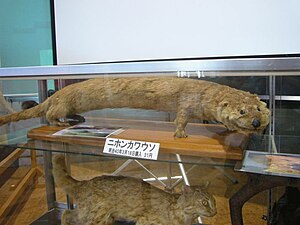Japanese otter
| Japanese otter | ||||||||||||
|---|---|---|---|---|---|---|---|---|---|---|---|---|

Museum specimen of the Japanese otter |
||||||||||||
| Systematics | ||||||||||||
|
||||||||||||
| Scientific name | ||||||||||||
| Lutra nippon | ||||||||||||
| Imaizumi & Yoshiyuki , 1989 |
The Japanese otter ( Lutra nippon ) is an extremely rare or already extinct species of the old world otter within the martens , although the species status is in doubt. It was historically common in the Japanese islands. He was last spotted on Shikoku Island in 1979 .
features
The appearance of the Japanese otter corresponds to the Eurasian otter. The head-torso length is in the range of about 90 centimeters and corresponds to the large individuals of the Asian subspecies of the Eurasian otter or is slightly larger. The tail is significantly longer in relation to the body than that of the Eurasian otter; in the Japanese otter it corresponds to 60 to 70% of the body length, in the Eurasian otter only 53 to 60%. Other differences concern the shape of the Rhinalium . The fur consists of short hair, the body color is dark brown to gray-brown with light brown parts. The ventral side is light with white hair. The throat and front nape of the neck are beige, the hair in the area of the upper lip is almost white.
The species description was mainly based on the skull. This is strongly built with a comparatively large facial skull and differs from the Eurasian otter in the position of individual windows such as the foramen ovale and the proportions of individual skull regions to one another.
Distribution and endangerment status
The Japanese otter may have been widespread in the Japanese islands earlier, but has been considered extinct in large parts of Japan since the Meiji period . Between 1955 and 1959 it was last sighted on Honshu, Kyusyu and Hokkaido. The last definite evidence was on Shikoku Island in 1979 when a dead specimen was found. A search for the species in the 1990s was fruitless.
Way of life
No information is available on the way of life of the Japanese otter. It can be assumed that it does not differ significantly from that of the Eurasian otter.
Systematics
The status of the Japanese otter as a separate species is controversial. It was separated from the Eurasian otter in 1989 by the Japanese zoologists Imaizumi and Yoshiyuki (1989) and described as a separate species. For example, while Wozencraft in Wilson and Reeder (2005) follows this assumption, the IUCN portrays the species status as uncertain and describes the Japanese otter as a population of the Eurasian otter.
The independent species status was supported in 1996 by a molecular-biological comparison of the mitochondrial gene for cytochrome b by Suzuki et al., In which a difference of 3.6% of the observed nucleotides was found. Since this difference is greater than that of the pair of species of fire weasel ( Mustela sibirica ) and Japanese weasel ( Mustela itatsi ), as well as the minimum difference in the corresponding DNA sequence determined in a study on the phylogeny of marten (minimum 3.5 %), the species status for the Japanese otter was confirmed.
supporting documents
- ↑ a b c d Yoshinori Imaizumi, Mizuko Yoshiyuki: Taxonomic status of the Japanese otter (Carnivora, Mustelidae), with a description of a new species. Bulletin of the National Science Museum. Series A, Zoology 15, 1989: pp. 177-188. ( Full text )
- ^ A b Don E. Wilson & DeeAnn M. Reeder (Eds.): Lutra nippon in Mammal Species of the World. A Taxonomic and Geographic Reference (3rd ed).
- ↑ Motokazu Ando, Mizuko Yoshiyuki, Sung-yong Han & Hyeong-Hoo Kim: Extinction of the Japanese otter: -lessons from its extinction - Paper presented in Xth International Otter Colloquium, Hwacheon, South Korea, 2007 PDF, online
- ↑ Lutra lutra in the endangered Red List species the IUCN 2011. Posted by: J. Ruiz-Olmo, A. Loy, C. Cianfrani, P. Yoxon, G. Yoxon, PK de Silva, A. Roos, M. Bisther, P. Hajkova, B. Zemanova, 2004. Retrieved April 15, 2012.
- ↑ Tomohiko Suzuki, Hajime Yuasa, Yoshihiko Machida: Phylogenetic Position of the Japanese River Otter Lutra nippon Inferred from the Nucleotide Sequence of 224 bp of the Mitochondrial Cytochrome b Gene. Zoological Science 13 (4), 1996: pp. 621-626. ( Abstract )
literature
- Yoshinori Imaizumi, Mizuko Yoshiyuki: Taxonomic status of the Japanese otter (Carnivora, Mustelidae), with a description of a new species. Bulletin of the National Science Museum. Series A, Zoology 15, 1989: pp. 177-188. ( Full text )
- Tomohiko Suzuki, Hajime Yuasa, Yoshihiko Machida: Phylogenetic Position of the Japanese River Otter Lutra nippon Inferred from the Nucleotide Sequence of 224 bp of the Mitochondrial Cytochrome b Gene. Zoological Science 13 (4), 1996: pp. 621-626